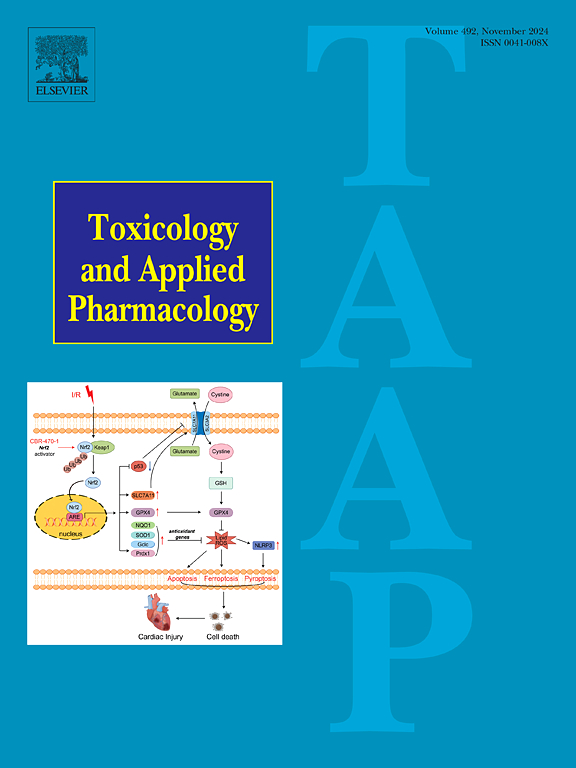Estimation of species- and sex-specific PFAS pharmacokinetics in mice, rats, and non-human primates using a Bayesian hierarchical methodology
IF 3.3
3区 医学
Q2 PHARMACOLOGY & PHARMACY
引用次数: 0
Abstract
The carbon chain length, degree of fluorination, and functional group of per- and polyfluoroalkyl substances (PFAS) influences the bioaccumulation and half-lives of these substances in humans and laboratory animals. Pharmacokinetic (PK) studies using laboratory animals characterize the absorption, distribution, metabolism, and excretion (ADME) of a PFAS and can provide the underlying data for inter-species extrapolation to inform human pharmacokinetics. However, variations in ADME arise due to differences in protein binding and renal and hepatobiliary clearance mechanisms. In particular, sex- and species-specific differences in active transporter abundance and PFAS binding affinity challenge body weight-based extrapolation assumptions from animal models to human PK parameters. Because these protein-dependent changes in ADME do not always scale with species body weight, classic allometric scaling assumptions can fail to account for species-specific transporter-mediated clearance. In addition, study-dependent differences in pharmacokinetic modeling approaches and parameterization techniques can result in large differences among the PK parameters reported in the literature. To better quantify PFAS pharmacokinetics and characterize the underlying uncertainty, we implemented a Bayesian inference hierarchical model to estimate PFAS PK parameters for multiple species (mice, rats, and non-human primates) using numerous single-dose animal studies. Through an alternative parameterization of the one- and two-compartment models, this method improved parameter identifiability and allowed for the use of prior information on PFAS absorption rate, clearance, and volume of distribution. Using reported time-course concentration data, we estimated sex-specific clearance, volume of distribution, and half-life across mice, rats, and non-human primates using a consistent modeling methodology for eight PFAS: PFHxA, PFHxS, PFNA, PFDA, PFBS, PFBA, PFOA, and PFOS. The resulting comparison to available human data demonstrated that standard volume of distribution body-mass scaling (BW1) for PFAS generally agrees with reported human values while standard assumptions for allometric scaling of clearance (BW3/4) are not appropriate for most of the PFAS investigated in this study. In addition, we demonstrated that there may be considerable differences in clearance for PFAS in some species when comparing across different sexes and routes of exposure.
使用贝叶斯层次方法估计物种和性别特异性PFAS在小鼠、大鼠和非人类灵长类动物中的药代动力学
单氟烷基和多氟烷基物质(PFAS)的碳链长度、氟化程度和官能团影响这些物质在人类和实验动物体内的生物蓄积和半衰期。实验动物的药代动力学(PK)研究表征了PFAS的吸收、分布、代谢和排泄(ADME),可以为物种间推断提供基础数据,从而为人类药代动力学提供信息。然而,ADME的变化是由于蛋白质结合和肾脏和肝胆清除机制的差异引起的。特别是,活性转运蛋白丰度和PFAS结合亲和力的性别和物种特异性差异挑战了从动物模型到人类PK参数的基于体重的外推假设。由于这些蛋白质依赖性的ADME变化并不总是与物种体重成比例,经典的异速缩放假设可能无法解释物种特异性转运体介导的清除。此外,药代动力学建模方法和参数化技术的研究差异可能导致文献中报道的PK参数之间存在很大差异。为了更好地量化PFAS药代动力学并表征潜在的不确定性,我们采用贝叶斯推理分层模型,通过大量单剂量动物研究来估计多物种(小鼠、大鼠和非人灵长类动物)PFAS的PK参数。通过对单室和双室模型的参数化,该方法提高了参数的可识别性,并允许使用PFAS吸收率、清除率和分布体积的先验信息。使用已报告的时间过程浓度数据,我们使用一致的建模方法估计了小鼠、大鼠和非人类灵长类动物的性别特异性清除率、分布体积和半衰期,包括PFHxA、PFHxS、PFNA、PFDA、PFBS、PFBA、PFOA和PFOS。结果与现有人类数据的比较表明,PFAS的标准分布体质量标度(BW1)与报告的人类值基本一致,而异速生长清除标度的标准假设(BW3/4)不适用于本研究中调查的大多数PFAS。此外,我们证明,当比较不同性别和暴露途径时,某些物种对PFAS的清除率可能存在相当大的差异。
本文章由计算机程序翻译,如有差异,请以英文原文为准。
求助全文
约1分钟内获得全文
求助全文
来源期刊
CiteScore
6.80
自引率
2.60%
发文量
309
审稿时长
32 days
期刊介绍:
Toxicology and Applied Pharmacology publishes original scientific research of relevance to animals or humans pertaining to the action of chemicals, drugs, or chemically-defined natural products.
Regular articles address mechanistic approaches to physiological, pharmacologic, biochemical, cellular, or molecular understanding of toxicologic/pathologic lesions and to methods used to describe these responses. Safety Science articles address outstanding state-of-the-art preclinical and human translational characterization of drug and chemical safety employing cutting-edge science. Highly significant Regulatory Safety Science articles will also be considered in this category. Papers concerned with alternatives to the use of experimental animals are encouraged.
Short articles report on high impact studies of broad interest to readers of TAAP that would benefit from rapid publication. These articles should contain no more than a combined total of four figures and tables. Authors should include in their cover letter the justification for consideration of their manuscript as a short article.

 求助内容:
求助内容: 应助结果提醒方式:
应助结果提醒方式:


